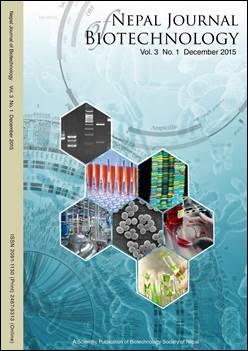Molecular Markers for Septoria Leaf Spot (Septoria lycopersicii Speg.) Resistance in Tomato (Solanum lycopersicum L.)
DOI:
https://doi.org/10.3126/njb.v3i1.14230Keywords:
Bulked segregant analysis, resistant bulk, septoria leaf spot, Solanum lycopersicum, susceptible bulkAbstract
Marker assisted selection (MAS) has not been initiated in tomato (Solanum lycopersicum L.) for septoria leaf spot (SLS) resistance caused by Septoria lycopersici Speg due to lack of molecular markers. We studied the inheritance of SLS resistance and identified molecular markers linked to SLS resistance using bulked segregant analysis (BSA) in a segregating F2 population. Tomato inbred lines, NC 85L-1W (2007), susceptible to SLS and NC 839-2(2007)-1, resistant to SLS were used to develop the segregating population. A total of 250 F2 plants, and 10 plants each of P1, P2 and F1 were grown at the Mountain Horticultural Crops Research and Extension Center (MHCREC), Mills River NC in the summer of 2009. Disease severity was scored using a scale of 0 to 5, where 0 = no disease and 5 = complete development of disease. DNA was extracted from 2-3 week old plants and parental lines were screened with a total of 197 random amplified polymorphic DNA (RAPD) primers, of which 34 were polymorphic. Two DNA bulks, called resistant bulk (RB) and susceptible bulk (SB) were prepared from the F2 individuals. The RB and SB consisted of 8 individuals each with disease scores of 0, and 4.0 or 4.5, respectively. The segregation ratio of resistant and susceptible plants in F2 generation fit the expected Mendelian ratio of 3:1 for a single dominant gene. Five RAPD markers were linked to the SLS disease reaction, of which two were linked to susceptibility and three to the resistance. Subject to verification in independent populations, these markers may be useful for MAS of SLS resistance in tomato.
Nepal Journal of Biotechnology. Dec. 2015 Vol. 3, No. 1: 40-47
Downloads
Downloads
Published
How to Cite
Issue
Section
License
Copyright Notice:
The manuscript submitted to NJB must be an original contribution, not previously published and should not be under consideration for publication elsewhere. When the manuscript is accepted for publication, the authors agree to automatically transfer the copyright of the article to the publisher. It should grant permission to any third party, in advance and in perpetuity, the right to use, reproduce or disseminate your article, according to the NJB copyright and license agreement.
Authors transfer copyright to the publisher as part of a journal publishing agreement but have the rights to: Share their article for Personal Use, Internal Institutional Use and Scholarly Sharing purposes, with the NJB applies the Creative Commons Attribution-NonCommercial CC BY-NC license to all the works we publish after Jun 2020 (Before it was CC BY-NC-ND). Under this license, authors agree to make articles legally available for reuse, without permission or fees, for virtually any non-commercial purpose. Anyone may remix, adapt, and build upon your work non-commercially, and although their new works must also acknowledge you and be non-commercial, they don’t have to license their derivative works on the same terms. More details on CC BY-NC refer to its Licence Deed and Legal Code.






